|
The Mystery of Ancient America's
ViewZone will attempt to give you all the details.
Dating the petroglyphs has been accomplished in the past by associating the styles and designs with similar designs found on pottery, whose dates are known. Another way of dating these carvings is to locate their use on formations in layers of the earth whose dates have been calculated by some other means. But these dating techniques are only circumstantial.
Several samples were run through this test for each site. Examples of all of the various grouped styles were sampled and averages ages were obtained. The results are below. (Thanks to Bill McGlone for sharing this data. References and inquiries will be forwarded.)
The oldest and most perplexing are the abstract petroglyphs. They do not remind us of anything recognizable. Sometimes they do look as if they could have been the writing of some unknown alphabet, while other times their meandering and random shapes totally allude us. It's unthinkable that these were done randomly. They are painstakingly pecked out of the rock surface with some effort and time by the carvers and, often but not always, they seem to have a hint of patterns or similarities. Some of these showed very old dates of up to 4700 years ago! Similar petroglyphs in other parts of the world have been dated back to the Bronze Age. The elk that we were able to trace on our previous site seems to be of this oldest type. At least if you group it into the "abstract" family. But it is most certainly not abstract. It's too early to guess.
 Since there are at least two very different styles in this group -- the meandering lines and the alphabetical shapes -- we will need to know which dates apply to which styles. The alphabetical symbols were dated at about the time of Christ, give or take a few hundred years. I'd prefer to see them in a different group because of the difference in time -- almost two thousand years difference -- but oddly they do appear related at some sites. The pictorial style is the next oldest. These shapes are often solidly pecked and not merely outlined. The examples of quadrupeds with horns and antlers are in this group. The petroglyphs in both Mystery Valley and the Sun Park of the Hopi are also in this group. Occasionally we will see shapes that are similar to the alphabetical style (like the "phi" sign). It is argued that the alphabet, similar to Thamudic, was carved BEFORE the pictorial petroglyphs -- as much as a thousand years before. This view believes the people who made the pictorial style "discovered" the rock art from some previous inhabitants and then used some of these symbols in their own system of rock art. This view assumes that there were different cultures in this same area at different times. But what if this was the same culture, evolving through thousands of years? We would now have to place the alphabet style AFTER the pictorial style because we would have the more organized alphabet system evolving from the earlier pictorial use of these same shapes. It would show intellectual evolution. But sadly, the dates show that the more organized alphabet was carved well before this use as symbols. The biographic style is easily differentiated from the other styles in that it is made by scraping the shape in the rock and not by pecking. The scars in the rock are usually deep and enduring, often made right on top of the faded abstract and pictorial petroglyphs. Dating of these petroglyphs was easy and it appears that there is little controversy. Again, we sometimes see similarities in the symbols of the Plains Indian petroglyphs and the alphabetical and abstract meandering lines, but this case of copying what was "discovered" is obvious and historically proven. The European style is very contemporary. Names and dates, hearts with arrows and often some famous people like Kit Carson are found in the area. The parallel lines are somewhat of an enigma in that they appear unrelated to all styles and seem to be about 3000 years old. How do they fit in with the cultures of this region? Our next and last stop on the map would yield some surprising information and some even more explosive evidence.
|


 If someone from a particular time in history was to bury and object, or dig up a previously buried object, this object would mistakenly be associated with the level of earth in which it was found. These types of errors were unavoidable. But now a direct method has been used. Professor Ronald Dorn (right) of Arizona State University developed a reliable radiocarbon dating method by sampling the varnish in the grooves of the petroglyphs. This rock varnish or patina forms very slowly in the hot, arid Colorado climate. The original artists would have pecked away at the dark varnish to uncover fresh bright rock. As the varnish forms over this fresh rock, it captures organic matter which can be separated and dated.
If someone from a particular time in history was to bury and object, or dig up a previously buried object, this object would mistakenly be associated with the level of earth in which it was found. These types of errors were unavoidable. But now a direct method has been used. Professor Ronald Dorn (right) of Arizona State University developed a reliable radiocarbon dating method by sampling the varnish in the grooves of the petroglyphs. This rock varnish or patina forms very slowly in the hot, arid Colorado climate. The original artists would have pecked away at the dark varnish to uncover fresh bright rock. As the varnish forms over this fresh rock, it captures organic matter which can be separated and dated.